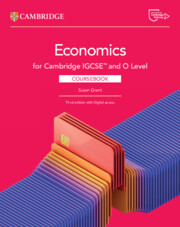This coursebook will help your students build an understanding of key economics concepts, with engaging imagery and real-life examples to ensure topics are accessible for all students. Engage your students with a variety of activities to encourage active learning, from writing a podcast script to conducting research as a group. Students will explore the importance of economics in society, through topics such as the basic economic problem, price elasticity and globalisation. Access videos in the digital version of the coursebook, to provide additional support for students with English as an additional language.
Features
- Varied activities, such as writing a report or producing and delivering a presentation, encourage active learning and provide formative assessment insights.
- 'Learning intentions' focus on what students will learn in each chapter and align to the syllabus objectives to provide structure.
- Engaging videos bring economic concepts into the classroom, providing explanations alongside real-life examples to support understanding.
- 'Economics in context' feature enables students to discuss real-world examples to help them understand key topics, such as quality of life and living standards in Sweden.
- Discussion questions help students explore topics in more depth and build their understanding in pairs or groups.
- 'Economics in action' feature allows students to make connections with the wider world with a focus on work, sustainability and global economic events.
- Key term definitions and concept links provide additional support throughout each chapter.
- Multiple choice practice questions help students prepare for assessment.
- 'Check your progress' feature and practice questions enable students to keep track of their learning and prepare for assessment.
- Tips are included throughout each chapter offering concise advice on key skills, such as essay writing, evaluation and analysis, as well as common errors.
- Accessibility Information: This publication meets the requirements of the EPUB Accessibility specification with conformance to WCAG 2.2 Level AA.
Table of Contents
- How to use this book
- Introduction
- Section 1. The basic economic problem
- Chapter 1. The nature of the economic problem
- Chapter 2. Factors of production
- Chapter 3. Opportunity cost
- Chapter 4. Production possibility curve diagrams
- End of section 1 practice questions
- Section 2. The allocation of resources
- Chapter 5. The role of markets in allocating resources
- Chapter 6. Demand
- Chapter 7. Supply
- Chapter 8. Price determination
- Chapter 9. Price changes
- Chapter 10 Price elasticity of demand (PED)
- Chapter 11. Price elasticity of supply (PES)
- Chapter 12. Market economic system
- Chapter 13. Market failure
- Chapter 14. Mixed economic system
- End of section 1 practice questions
- Section 2. Section 3. Microeconomic decision makers
- Chapter 15. Money and banking
- Chapter 16. Households
- Chapter 17. Workers
- Chapter 18. Firms
- Chapter 19. Firms and production
- Chapter 20. Firms' costs, revenue and objectives
- Chapter 21. Types of markets
- End of Section 3 practice question
- Section 4. Government and the macroeconomy
- Chapter 22. Government macroeconomic intervention
- Chapter 23. Fiscal policy
- Chapter 24. Monetary policy
- Chapter 25. Supply-side policy
- Chapter 26. Economic growth
- Chapter 27. Employment and unemployment
- Chapter 28. Inflation and deflation
- End of section 5 practice questions
- Section 5. Economic development
- Chapter 29. Living standards
- Chapter 30. Poverty
- Chapter 31. Population
- Chapter 32. Differences in economic development between countries
- End of section 5 practice questions
- Section 6. International trade and globalisation
- Chapter 33. Specialisation and free trade
- Chapter 34. Globalisation and trade restrictions
- Chapter 35. Foreign exchange rates
- Chapter 39. Current account balance of payments
- End of section 6 practice questions.
Advice on useful tools
Advice on useful tools, activities and timetabling from teachers experiencing school closures.
Cambridge GO
All our supporting resources have now moved to Cambridge GO – the new home for your Cambridge digital content.
Listen to our podcast
Listen to our podcast to discover teaching inspiration & advice from leading educational thinkers.




